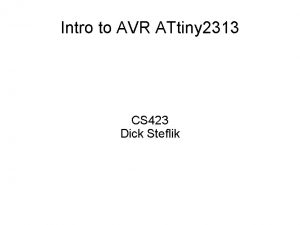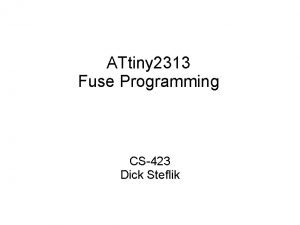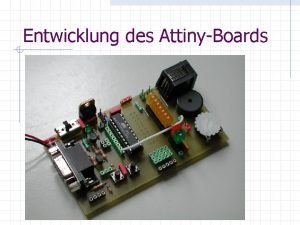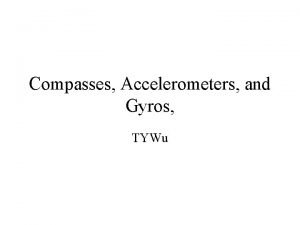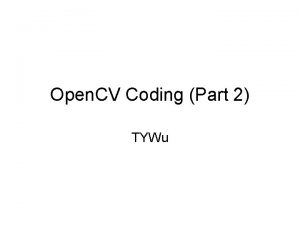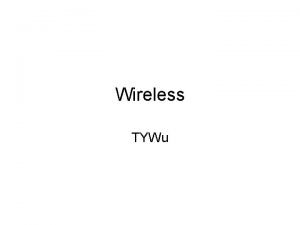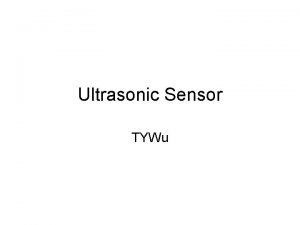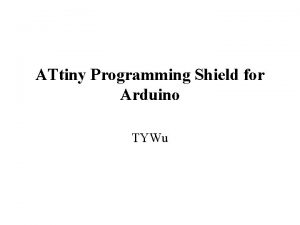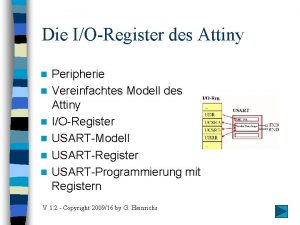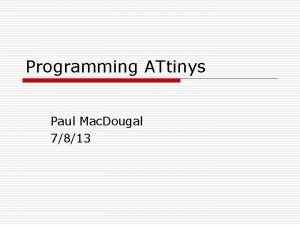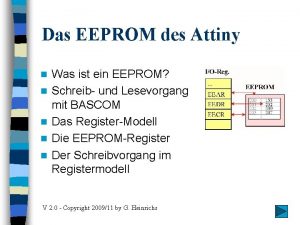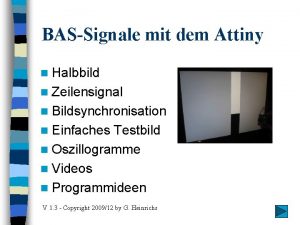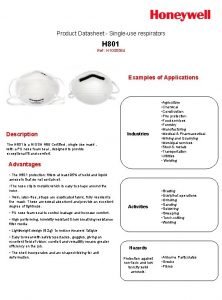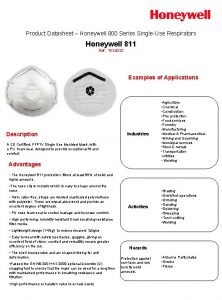ATtiny 85 Datasheet TYWu Family Attiny Family 8










![Power-Down Mode • When the SM[1: 0] bits are written to 10, the SLEEP Power-Down Mode • When the SM[1: 0] bits are written to 10, the SLEEP](https://slidetodoc.com/presentation_image_h2/8770cf1f0c7cf68d56d7d12591689424/image-11.jpg)



- Slides: 14

ATtiny 85 Datasheet TYWu


Family • Attiny Family (8 -bit Microprocessor) (2/4/8 K Bytes of In-System Programmable Program Memory Flash ) – ATtiny 25 – ATtiny 45 – ATtiny 85 • Brothers – ATMEGA 328 (8 bits) (Arduino UNO) – ATSAMD 21 (32 bits ARM® Cortex®-M 0)

Features • High-performance ? (1 MHz, 8 MHz, or 20 MHz) • Low Power Consumption – Active Mode • 1 MHz, 1. 8 V: 300 µA – Power-down Mode • 0. 1 µA at 1. 8 V • Exercise – 400 MAH (milliamp hours) – How long can an ATtiny run on the battery?

Features • 8 -bit AVR RISC-based microcontroller • 8 KB ISP flash memory – Program Size • 512 B EEPROM – Saving non volatile data • 512 -Byte SRAM – For Stacks, Variables, etc.

Features • Endurance of Non-volatile Memories – Programmable Program Memory Flash • 10, 000 Write/Erase Cycles – EEPROM • 100, 000 Write/Erase Cycles

Features • 2. 7 - 5. 5 V for ATtiny 25/45/85 • 10 -bit ADC • No DAC

Pins • Port B (PB 0~PB 5) is a 6 -bit bi-directional I/O port with internal pull-up resistors (selected for each bit). • ADCx: ADC Input Channel x • PWM

Pins • PWM • Discussion – Applications

Power-Down Mode • Power-down mode – Saves the register contents – Disabling all chip functions until the next Interrupt or Hardware Reset. – ADC Noise Reduction mode stops the CPU and all I/O modules except ADC, to minimize switching noise during ADC conversions
![PowerDown Mode When the SM1 0 bits are written to 10 the SLEEP Power-Down Mode • When the SM[1: 0] bits are written to 10, the SLEEP](https://slidetodoc.com/presentation_image_h2/8770cf1f0c7cf68d56d7d12591689424/image-11.jpg)
Power-Down Mode • When the SM[1: 0] bits are written to 10, the SLEEP instruction makes the MCU enter Power -down mode. • In this mode, the Oscillator is stopped, while the external interrupts, the USI start condition detection and the Watchdog continue operating (if enabled).

Power-Down Mode • Only an External Reset, a Watchdog Reset, a Brown-out Reset, USI start condition interrupt, an external level interrupt on INT 0 or a pin change interrupt can wake up the MCU. • This sleep mode halts all generated clocks, allowing operation of asynchronous modules only. • When this Oscillator is used as the chip clock • Watchdog Oscillator will still be used for the Watchdog Timer (WDT).

DC Characteristics

Reference • http: //ww 1. microchip. com/downloads/en/De vice. Doc/Atmel-2586 -AVR-8 -bit. Microcontroller-ATtiny 25 -ATtiny 45 ATtiny 85_Datasheet. pdf
